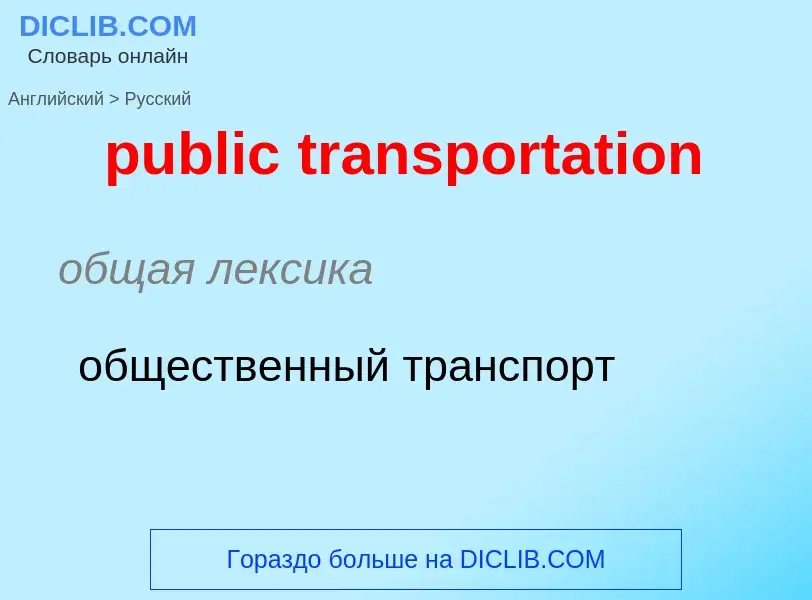Перевод и анализ слов искусственным интеллектом ChatGPT
На этой странице Вы можете получить подробный анализ слова или словосочетания, произведенный с помощью лучшей на сегодняшний день технологии искусственного интеллекта:
- как употребляется слово
- частота употребления
- используется оно чаще в устной или письменной речи
- варианты перевода слова
- примеры употребления (несколько фраз с переводом)
- этимология
public transportation - перевод на русский
общая лексика
общественный транспорт
строительное дело
общественный транспорт
строительное дело
общественный транспорт
Википедия

Public transport (also known as public transportation, public transit, mass transit, or simply transit) is a system of transport for passengers by group travel systems available for use by the general public unlike private transport, typically managed on a schedule, operated on established routes, and that charge a posted fee for each trip. There is no rigid definition; the Encyclopædia Britannica specifies that public transportation is within urban areas, and air travel is often not thought of when discussing public transport—dictionaries use wording like "buses, trains, etc." Examples of public transport include city buses, trolleybuses, trams (or light rail) and passenger trains, rapid transit (metro/subway/underground, etc.) and ferries. Public transport between cities is dominated by airlines, coaches, and intercity rail. High-speed rail networks are being developed in many parts of the world.
Most public transport systems run along fixed routes with set embarkation/disembarkation points to a prearranged timetable, with the most frequent services running to a headway (e.g.: "every 15 minutes" as opposed to being scheduled for any specific time of the day). However, most public transport trips include other modes of travel, such as passengers walking or catching bus services to access train stations. Share taxis offer on-demand services in many parts of the world, which may compete with fixed public transport lines, or complement them, by bringing passengers to interchanges. Paratransit is sometimes used in areas of low demand and for people who need a door-to-door service.
Urban public transit differs distinctly among Asia, North America, and Europe. In Asia, profit-driven, privately owned and publicly traded mass transit and real estate conglomerates predominantly operate public transit systems. In North America, municipal transit authorities most commonly run mass transit operations. In Europe, both state-owned and private companies predominantly operate mass transit systems.
For geographical, historical and economic reasons, differences exist internationally regarding use and extent of public transport. While countries in the Old World tend to have extensive and frequent systems serving their old and dense cities, many cities of the New World have more sprawl and much less comprehensive public transport. The International Association of Public Transport (UITP) is the international network for public transport authorities and operators, policy decision-makers, scientific institutes and the public transport supply and service industry. It has 3,400 members from 92 countries from all over the globe.
In recent years, some high-wealth cities have seen a decline in public transport usage. A number of sources attribute this trend to the rise in popularity of remote work, ride-sharing services, and car loans being relatively cheap across many countries. Major cities such as Toronto, Paris, Chicago, and London have seen this decline and have attempted to intervene by cutting fares and encouraging new modes of transportation, such as e-scooters and e-bikes. Because of the reduced emissions and other environmental impacts of using public transportation over private transportation, many experts have pointed to an increased investment in public transit as an important climate change mitigation tactic.


![A [[Sydney Trains]] A Set arriving to [[Flemington, New South Wales]] A [[Sydney Trains]] A Set arriving to [[Flemington, New South Wales]]](https://commons.wikimedia.org/wiki/Special:FilePath/A32 approaching Flemington (cropped).jpg?width=200)
![Water bus (''[[vaporetto]]'') at bus stop in [[Venice]], Italy Water bus (''[[vaporetto]]'') at bus stop in [[Venice]], Italy](https://commons.wikimedia.org/wiki/Special:FilePath/Accademia-vaporetto-stop-20050525-016.jpg?width=200)
![Beijing West]] Beijing West]]](https://commons.wikimedia.org/wiki/Special:FilePath/CRH380A-2685 at Motan (20190421095115).jpg?width=200)
![Chiba]], Japan Chiba]], Japan](https://commons.wikimedia.org/wiki/Special:FilePath/Chiba-Type-0-28F.jpg?width=200)

![streetcar in Toronto]], which operates the largest tramway in North America streetcar in Toronto]], which operates the largest tramway in North America](https://commons.wikimedia.org/wiki/Special:FilePath/Flexity outlook 4403 heading south, 2014 08 31 (8) (14918534190).jpg?width=200)

![People mover vehicle of [[Morgantown Personal Rapid Transit]] People mover vehicle of [[Morgantown Personal Rapid Transit]]](https://commons.wikimedia.org/wiki/Special:FilePath/Morgantown PRT - Beechurst Station.jpg?width=200)
![Early trolley car in [[Newton, Massachusetts]] Early trolley car in [[Newton, Massachusetts]]](https://commons.wikimedia.org/wiki/Special:FilePath/Newtonbostoncar.jpg?width=200)

![SkyTrain]] in [[Vancouver]] is the longest rapid transit system in Canada. SkyTrain]] in [[Vancouver]] is the longest rapid transit system in Canada.](https://commons.wikimedia.org/wiki/Special:FilePath/Skytrain Mark II-300.jpg?width=200)
![Baltic railway station]] in [[Tallinn]], Estonia Baltic railway station]] in [[Tallinn]], Estonia](https://commons.wikimedia.org/wiki/Special:FilePath/Solaris Trollino 12 Tallinn 2015.jpg?width=200)
![[[Traffic jam]] in [[São Paulo]], Brazil [[Traffic jam]] in [[São Paulo]], Brazil](https://commons.wikimedia.org/wiki/Special:FilePath/Traffic jam Sao Paulo 09 2006 30a.jpg?width=200)
![The [[SmartRider]] is a [[smart card]] for public transportation tickets in [[Perth]], Western Australia The [[SmartRider]] is a [[smart card]] for public transportation tickets in [[Perth]], Western Australia](https://commons.wikimedia.org/wiki/Special:FilePath/Transperth SmartRider Card.jpg?width=200)
![[[Transperth]] bus operating in [[Perth]], Western Australia [[Transperth]] bus operating in [[Perth]], Western Australia](https://commons.wikimedia.org/wiki/Special:FilePath/Transperth Volvo B8RLE (Volgren Optimus) TP2869 @ Elder Place,Fremantle (cropped).jpg?width=200)
![A contactless validator in [[Brno]] A contactless validator in [[Brno]]](https://commons.wikimedia.org/wiki/Special:FilePath/Validátor jízdenek Brno.jpg?width=200)
